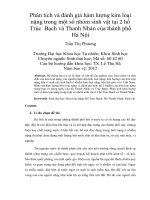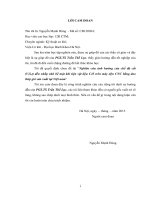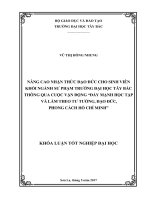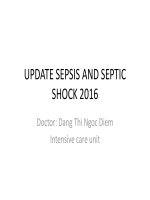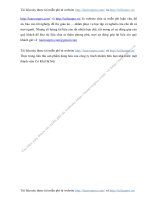C P NH T NHI M TR NG HUY T V S C NHI M
Bạn đang xem bản rút gọn của tài liệu. Xem và tải ngay bản đầy đủ của tài liệu tại đây (841.51 KB, 22 trang )
UPDATE SEPSIS AND SEPTIC
SHOCK 2016
Doctor: Dang Thi Ngoc Diem
Intensive care unit
CONTENTS
• INTRODUCTION
• DEFINITIONS
• SURVIVING SEPSIS CAMPAIGN 2016
DEFINITIONS
Sepsis
Septic shock
Life threatening
Organ dysfunction
Caused by a dysregulated
host response
To infection
Septic shock is a subset of
sepsis in which profound
circulatory, cellular and
metabolic abnormalities are
associated with a greater
risk of mortality than sepsis
alone
CLINICAL CRITERIA
The overlap SIRS, infection, sepsis and
inflammation
Initial resuscitation
Infusion venous fluid recommendation:
• Initial fluid challenge ≥ 1000ml or minimum of
30ml/kg of crystalloids in the 1st 4-6hours
(strong recommendation, grade 1C)
• Crystalloids is the initial fluid for resuscitation
(strong recommendation, grade 1A)
• Add albumin to the initial fluid resuscitation
(weak recommendation, grade 2B)
Follow
• Dynamic over static variables be used to predict fluid
responsiveness, where available
(weak recommendation, low quality of evidence).
• Initial target mean arterial pressure (MAP) of 65 mm Hg
in patients with septic shock requiring vasopressors
(strong recommendation, moderate quality of evidence).
• Resuscitation to normalize lactate in patients with
elevated lactate levels
(weak recommendation, low quality of evidence).
Reassessment of volume status and tissue
perfusion
• Either: Vital signs, cardiopulmonary, capillary
refill, pulse, and skin findings
• Or two of the following:
CVP
ScvO2
Bedside cardiovascular ultrasound
Dynamic assessment of fluid responsiveness
with passive leg raise or fluid challenge
Antibiotics
1. Administration of IV antimicrobials be initiated as soon as
possible after recognition and within one hour for both sepsis
and septic shock
(strong recommendation, moderate quality of evidence)
2new. Empiric broad-spectrum therapy for patients presenting
with sepsis or septic shock.
(strong recommendation, moderate quality of evidence).
3. Empiric antimicrobial therapy be narrowed once pathogen
identification and sensitivities are established and/or adequate
clinical improvement is noted (BPS).
Antibiotics
4. Against sustained systemic antimicrobial prophylaxis in patients
with severe inflammatory states of noninfectious origin (e.g.,
severe pancreatitis, burn injury) (BPS).
5. Dosing strategies of antimicrobials be optimized based on
accepted pharmacokinetic/pharmacodynamic principles and
specific drug properties in patients with sepsis or septic shock
(BPS).
6. Empiric combination therapy aimed at the most likely bacterial
pathogen(s) for the initial management of septic shock
(weak recommendation, low quality of evidence)
Antibiotics
7. Combination therapy not be routinely used for ongoing
treatment of most other serious infections, including bacteremia
and sepsis without shock
(weak recommendation, low quality of evidence)
8new. Against combination therapy for the routine treatment of
neutropenic sepsis/bacteremia
(strong recommendation, moderate quality of evidence)
9. De-escalation with discontinuation of combination therapy in
response to clinical improvement and/or evidence of infection
resolution (BPS).
10. Antimicrobial treatment duration: 7 to 10 days
(weak recommendation, low quality of evidence).
11. Longer courses are appropriate in specific patients (*)
(weak recommendation, low quality of evidence).
12. Shorter courses are appropriate in some patients (**)
(weak recommendation, low quality of evidence).
13. Daily assessment for de-escalation (BPS).
(*) slow clinical response, undrainable foci of infection, bacteremia with S aureus, some
fungal and viral infections, or immunologic deficiencies, including neutropenia
(**) rapid clinical resolution following effective source control of intra-abdominal or
urinary sepsis and those with anatomically uncomplicated pyelonephritis
14new. Measurement of procalcitonin levels can be used to support
shortening the duration of antimicrobial therapy in sepsis patients
(weak recommendation, low quality of evidence).
15new.Procalcitonin levels can be used to support the discontinuation
of empiric antibiotics
(weak recommendation, low quality of evidence).
Source control
1. Specific anatomic diagnosis of infection requiring emergent
source control be identified or excluded as rapidly as possible
in patients with sepsis or septic shock (BPS).
2. Prompt removal of intravascular access devices that are a
possible source of sepsis or septic shock after other vascular
access has been established (BPS).
Thank you !!

